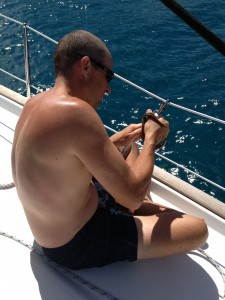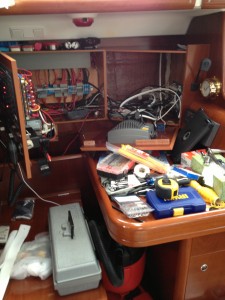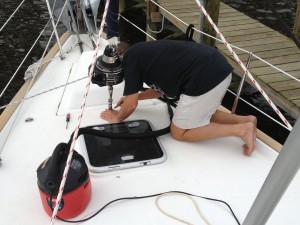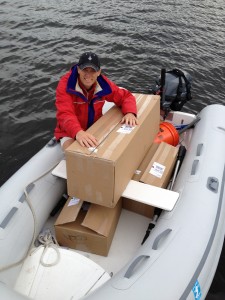Passage/Caribbean Preparations
Written By Chris Conway
I don’t think it is possible to ever get everything done on the to-do list for a passage. In the time leading up to our departure, there were days where I ended the day with a longer list of things to do than I began the day with. I was focusing on what I deemed a priority for our safe, fast passage in addition to prepping for time away from easy access to marine supply shops. The list included a focus on servicing the engine, generator, rig, electrical systems, heads and upgrading the ground tackle.
For the generator, we were lucky enough to come across Karl, an experienced Fisher Panda mechanic in Annapolis. He gave the generator a thorough inspection and performed some basic maintenance including an oil change and valve adjustment. He also pointed out several installation issues such as the overflow freshwater cooling bottle mounted below the generator, rendering it useless. Additionally I purchased the Fisher Panda spare parts kit and Karl took the time to show me some of the key parts and what parts you can work around or remove entirely and still get the generator to start. It was well worth the few hours we spent with Karl to get at least some familiarity with the generator.
The engine has been running great (knock wood…) so I was just performing some basic maintenance and a general inspection. I ended up changing out the oil, oil filter, fuel filter(s) and the transmission fluid. Otherwise the engine looked like it was in good shape. I also checked the sea water impeller which looked perfect so I left it in place. A future project will be to upgrade the pulley systems to a serpentine belt to better handle the high output Balmar alternator.
In Annapolis we scheduled a visit from a rigging company to hopefully address the issue of the inner forestay halyard parting. In addition to the inner forestay work, we also had some halyard work done. We upgraded the main halyard to one of the new low stretch spectra or vectran or whatever they call the expensive ones these days and added a port spinnaker halyard so we would have two wing halyards in case one was parted. The rigging work took longer than expected, but we hoped our halyard issues would be resolved.
We also scheduled a visit from a marine electrician to check out our batteries. I had thought that one of the batteries may have been damaged early in our trip when a fuse went bad effectively removing two of the three batteries from the house bank. That meant that we ran on one house battery for about a week until I finally tracked down the issue. During that time we were deeply discharging the one battery since we thought we were on a 600 amp hour system instead of a 200 amp hour system. We were also concerned with the rapid disappearance of the zincs on the prop. The electrician tested all the batteries and also performed some tests on the electrolysis and everything tested out perfectly. It was worth the visit to get rid of the anxiety. Sometimes the internet can be detrimental as everything you read about AGM batteries says that if you look at it wrong it is ruined.
The heads continue to be an issue since everyone but me insists on using the bathrooms on the boat. On the list was to change out all the hoses as they were original and had some odor issues developing. I also had to do some work on the macerators to make sure we can empty the holding tanks when far enough offshore. The electric pump for our head also needed to be rebuilt to replace all the gaskets and seals since it was beginning to leak.
While in Annapolis we enjoyed a nice stay at the Annapolis Landing Marina. One of the perks of staying there was access to a courtesy car which meant I could spend more money at West Marine and Faucett’s. I had been uneasy with our ground tackle situation for some time now as the boat originally had a Delta 55lb as the primary and a Fortress FX37 as the backup. Before we left on our trip I had upgraded to 250 ft of 3/8 BBB chain for the Delta and moved the 25ft of chain that was on the Delta to the Fortress along with the 200 ft nylon rode. I had wanted to add a third anchor since in a storm situation I would most likely have two deployed at once. After exchanging emails with some of the other Beneteau 473 owners that I “met” through the Yahoo group, I decided on adding a 60lb Manson Supreme anchor. One of the other owners had been able to get this anchor along with another in his bow rollers, which was my biggest concern. I ended up cutting 70 feet off of the primary chain so I would have 180 ft of chain on the new primary anchor and 70 feet for the Delta which would serve as a backup secondary anchor. Little did I know at the time that 10 days later I would be riding out a hurricane on the new Manson Supreme along with the Fortress with the Delta as a backup.
In addition to the above, I was working on at least the high level overview of some other projects to see what parts I might need to finish them up. This included the installation of our new Wi-Fi antenna and router and the water maker. For the water maker I was just trying to estimate what parts I may need for the plumbing and the installation of the major components.
Finally, I was working on what programs to use for email and weather data. I settled on “mail a sail” which aside from an initial glitch in activation has been working well. The GRIB files, which provide the surface winds and air pressure, are being retrieved through saildocs, which worked out great. I was able to access the email through the Globalstar phone and pull the GRIB file into my OpenCPN plotter program to view the winds in my area as well as the forecast going 7 days out.
As I said in the beginning, there is no way to get to everything, but I completed the tasks needed to keep us safe on our passage. The rest of the To-Do list will be waiting for me in the BVIs!





Great job Chris. Brought back a lot of memories for me. Enjoy the rest of your cruise, and always be safe.